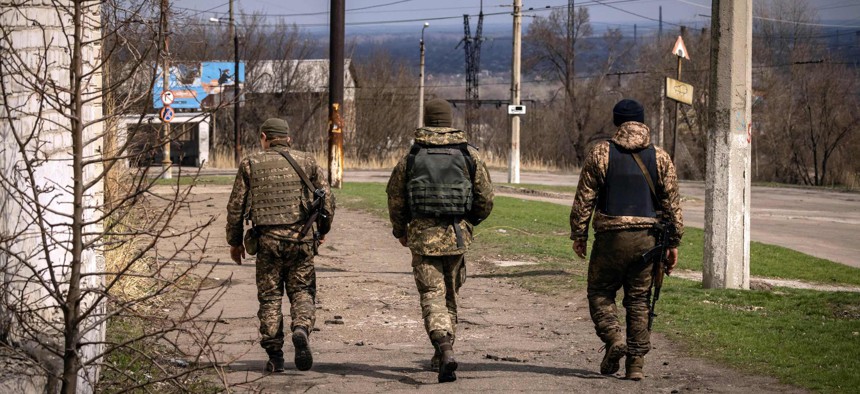
Ukrainian servicemen walk in the city of Severodonetsk, in the Donbass region of Ukraine, on April 6, 2022, as Ukraine tells residents in the country's east to evacuate "now" or "risk death" ahead of a feared Russian onslaught . AFP via Getty Images / FADEL SENNA
Russia, Ukraine, and the Misuse of History
Strained analogies do nothing but mislead us about what comes next.
In the five weeks since Russia invaded Ukraine, scores of articles have drawn upon history to explain Moscow's actions and intent. Some point to the Soviet suppression of a democracy movement in Hungary in 1956, while others draw lessons from the Russian Federation’s assault on the Chechen city of Grozny in 1999. The idea seems to be to fit Russia’s actions in Ukraine into a “playbook” that might tell us what happens next. But this approach, whether applied to the current conflict or others, often obscures the uniqueness of given historical events. The 20th-century philosopher George Santayana said that those who do not understand the past are condemned to repeat it. Notice that Santayana chose the word “past” and not the word “history.” That is because history constructs a story of the past; history itself is not repeatable.
But it is important, and historical cases can offer lessons and insights about potential pitfalls that lie ahead. Understanding how present events differ from those of the past adds additional, vital nuance to analysis. Conversely, drawing straight lines from history to explain today’s situation is not particularly helpful because Russia’s actions in Ukraine are without parallel. Russia, today, is not the Soviet Union; the Russian military not the Red Army; Ukraine is not Chechnya; this war is not like Afghanistan in the 1980s. Or in other words history does not quite repeat itself.
History as playbook has been used to paint the Ukraine conflict as start of larger battle for Europe. Citing 20th-century events, some have suggested that after Ukraine, Russia will move on to other countries, like the Baltics or Poland. The Soviet suppression of pro-democracy movements in Hungary in 1956, in Czechoslovakia in 1968, and once again in Poland in 1980, suggest a sequence of dominoes that have fallen in the past, and will continue now with the Russians in Ukraine.
But even if it is Putin’s intent to knock over one domino of a European country after another, the Russian Army—unlike the Soviet Army of old—simply does not have the capacity to do that. Eastern European countries are no longer members of the Soviet Bloc, but rather members of NATO and the European Union, and as such have collective defense agreements that make it unlikely that Russia could pick them off one at a time. Moreover, with an estimated three-quarters of its battalion tactical groups committed to Ukraine, Russia does not have the combat nor the logistical capability to widen the conflict further. At this point, it is barely holding onto slivers of Ukrainian territory on the eastern edge of the country. Even the thought of attacking to the west, to seal off the border with Poland, is a pipe dream.
History has also been used to predict the operational contours of the Ukraine conflict. In particular, the fact that Russians turned most of the Grozny to rubble has been used to argue that Moscow will likely adopt a similar approach today in Ukraine. However, the differences between Ukraine today and Chechnya in 1999 are important. Chechnya was a small Russian territory with 1.3 million inhabitants; Ukraine is a sovereign nation with over 43 million people. Grozny had less than a fifth the number of residents and a third of the geographical area of Ukraine’s capital, Kyiv. As such, Russia in 1999 could easily surround Grozny and pummel it to the ground without any real fear of Chechen attacks against it. Not so with Kyiv.
Finally, history has been used to predict the duration of the conflict. The analogy commonly used here is the case of the Soviet Army in Afghanistan. In that war, the Soviet Army remained in Afghanistan for about a decade, while suffering at least 15,000 casualties. The argument is that Ukraine will become a similarly protracted conflict. But again, the differences between then and now, and the two invaded nations, are crucial: The Soviet deployment to Afghanistan—some 115,000 troops at its peak—was still only 2.5 percent of the 4.5-million-man Soviet Army at that time. The casualties that Russia is suffering in Ukraine are orders of magnitude higher than in Afghanistan. It appears that Russia may have already lost 7,000 to 15,000 soldiers in just the first month. Moreover, military support given to Ukrainians—already amounting to billions of dollars from 25 countries—is an order of magnitude more than what the United States gave to the Afghan mujahadeen in the early years of the Soviet campaign.
Historical analogies allow us to make sense of complex world events. They should not be seen as a “playbook” to divine the future. In fact, treating them as such can have the opposite effect: It can cause us to misread the present.
Gian Gentile is a senior historian and Raphael S. Cohen is a senior political scientist at the nonprofit, nonpartisan RAND Corporation




